MAINE, USA — Maine is known for its scenic landscapes, forests, and having the only national park in the northeast.
In the region, though, invasive plants are becoming an environmental concern that has increased as temperatures warm because of climate change.
Biologists at Acadia National Park have been managing invasive plants for years, but “climate change is exacerbating the issue,” according to Acadia vegetation biologist Jesse Wheeler.
Invasive plants in the region have faster growth in the spring and longer growing seasons in the fall because of climate change, Wheeler said. Warmer temperatures stress native species, but invasive plants are poised to take advantage of the conditions.
Wheeler said some invasive plant species he manages are known as “sleeper species,” meaning they’ve been in the northeast for more than 100 years, but the warmer temperatures are allowing those species to become invasive.
While it is a growing issue, Acadia is on the leading front to tackle the issue in comparison to other parks in the northeast region of the U.S.
"We're on sort of the leading front of both where species are coming toward, so we're sort of in that northern range of a lot of the invasive species, but we also have active management going on,” Wheeler said of Acadia. “I think that is sort of a ray of hope for us that we can kind of stay in front of some of these as we also anticipate more challenges coming as the climate warms.”
Wheeler said Acadia is one of the healthiest northeastern parks in terms of having the least amount of invasive plants. However, he’s expecting the northeast to be a hotspot for invasive species as a result of the changing climate.
Of all the plant species documented in Acadia, almost a quarter if them are nonnative. Of that list, there's a small subset of invasive plants, a couple dozen or so, that are found in Acadia.
When Acadia's resource staff finds invasive plants or nonnative plants that are predicted to become invasive in the future, early detection and rapid response is the key to managing the issue.
In the park's effort to minimize invasive plants in the park, a crew visits 100 different sites per year on a six-month basis and surveys the land.
Maine's state horticulturist with the Maine Department of Agriculture, Conservation and Forestry said there are "a lot of cascading effects from invasive species and invasive plants."
Gary Fish said the drought Maine has endured this summer puts stress on native plants, allowing invasive plants that are more tolerant to the drought "bully" and fill in certain areas.
The department's "do not sell list" includes plants that are banned and not allowed for import or sale. Thirty-three plants are currently banned in the state of Maine; 30 more plants were recently added and will be banned starting Jan. 1 2024.
There is also a "watch list" for plants that should be reviewed in five years that are invasive in states south of Maine. Plants on the watch list are more likely to become invasive in Maine as the climate continues to change.
"It's better to prevent the plant from becoming invasive then it is to manage it after it becomes widespread," Gary Fish, a state horticulturist, said.

